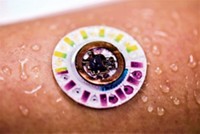Advertisement
Grab your lab coat. Let's get started
Welcome!
Welcome!
Create an account below to get 6 C&EN articles per month, receive newsletters and more - all free.
It seems this is your first time logging in online. Please enter the following information to continue.
As an ACS member you automatically get access to this site. All we need is few more details to create your reading experience.
Not you? Sign in with a different account.
Not you? Sign in with a different account.
ERROR 1
ERROR 1
ERROR 2
ERROR 2
ERROR 2
ERROR 2
ERROR 2
Password and Confirm password must match.
If you have an ACS member number, please enter it here so we can link this account to your membership. (optional)
ERROR 2
ACS values your privacy. By submitting your information, you are gaining access to C&EN and subscribing to our weekly newsletter. We use the information you provide to make your reading experience better, and we will never sell your data to third party members.
Chemical Sensing
How to make a sweat sensor for drugs
Guidelines include how to deal with pesky interfering signals when making voltammetric sensors
by Louisa Dalton, special to C&EN
February 11, 2020

Most oral medicines easily slip into sweat, which makes sweat sensors well suited to tracking pharmaceutical consumption. But a pitfall for drug monitoring in sweat is interfering electroactive molecules like amino acids that can mask the desired drug signal. Researchers now present design guidelines for creating electroactive drug sensors for sweat that include a strategy for avoiding or working around the interfering molecules (ACS Sens. 2020, DOI: 10.1021/acssensors.9b02233). The guidelines helped them create an effective sensor for monitoring dipyridamole, a drug given after heart surgery.
Correct dosing for certain drugs, especially for babies and the elderly, can be tricky since weight, age, other medicines, diet, and a patient’s unique body metabolism all affect drug concentration. Patients can submit to regular blood tests to monitor levels, but both patients and doctors would welcome a faster, noninvasive method. If properly made, wearable sweat sensors could let patients know painlessly when it is safe to take their next medication dose, says Sam Emaminejad at the University of California, Los Angeles.
Some prototypes of wearable sweat sensors measure electrolytes via an ion-selective electrode or detect glucose, lactate, and other biomarkers with the help of a probe such as an enzyme. Oral medications often have no readily available probe, yet are electroactive, Emaminejad says, which means that they can be measured directly in sweat via voltammetry without the need for probes. Voltammetric sensing can detect many drugs at once.
But voltammetric drug detection must be done carefully, Emaminejad cautions. Any electroactive molecule in sweat, particularly four amino acids and uric acid that occur naturally, can hide or overlap a target drug’s peak. Emaminejad and his group came up with a framework for designing a well-thought-out voltammetric sensor that performs well in real sweat. The key to their approach is characterizing interference by other molecules.
Emaminejad’s group fully characterized the background current and voltammetric signal for the five key confounders in sweat. The signals for certain drugs, like dipyridamole, fall in a low voltage window where these interfering molecules have no signal, making detection easy. But signals for others like caffeine and acetaminophen fall in a window that overlaps sweat components’ signals. In these cases, researchers need to do more work to filter out the offending interfering signal, Emaminejad says, by adding filters to the sensor surface or using algorithms to separate the signals. The interference study helped them create a sensor that detected dipyridamole spiked into a natural, human sweat sample.
“Interference is something that researchers ignore all too often with sensor work,” says Jason Heikenfeld, entrepreneur in wearable technology at the University of Cincinnati. He says that accounting for interference sets the groundwork for creating sweat sensors that can be used and tested not just in the lab but on people.
Before such a sensor could be used practically, clinical studies that correlate drug concentrations between blood and sweat are needed, Emaminejad says. Future well-designed sweat sensors, he hopes, will reveal a patient’s medicine metabolism in real time, help doctors target just-right dosing, and build individualized drug-response profiles.





Join the conversation
Contact the reporter
Submit a Letter to the Editor for publication
Engage with us on Twitter